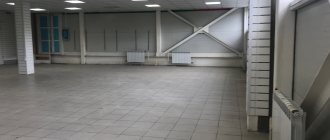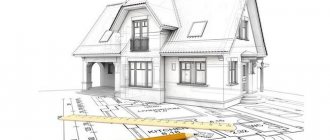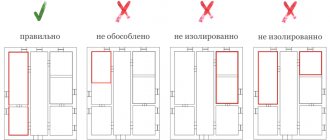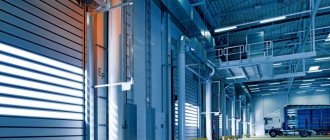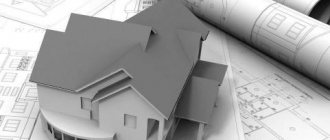Authors: Zemsky Gennady Timofeevich – leading researcher, candidate of chemical sciences, senior researcher;
Ilyichev Alexander Valerievich – deputy head of department – head of sector; Zuikov Vladimir Aleksandrovich – leading researcher, candidate of technical sciences, senior researcher; Kondratyuk Natalya Valentinovna – senior researcher; Averkina Natalya Borisovna – senior researcher (FGBU VNIIPO EMERCOM of Russia) The article was published in the journal Current Issues of Fire Safety (No. 4, 2020)
An inaccurate definition of the term gives rise to ambiguous interpretation and, as a result, distortion (wrong choice) of fire prevention measures. The authors of this article analyzed several of the most frequently used terms used in regulations and normative documents, and came to the conclusion that the definitions of many terms need adjustment, and also formulated proposals for changing the definitions of some terms and individual paragraphs of the Technical Regulations on fire safety requirements and sets of rules.
Premises
A room is a part of the volume of a building or structure that has a specific purpose and is limited by building structures [Article 2, Clause 14 384-FZ]. This definition includes not only rooms, but also corridors, halls, vestibules, shafts and other parts of the building volume. There is another definition of room:
1) room, zone (space): Space inside a building that has a specific functional purpose and is limited by building structures or conventional boundaries [clause 4.1.1 GOST R 58033-2017]. Here the words “or by conventional boundaries” cause confusion, since it is possible to highlight a room even with drawn boundaries, or screens, or partitions that do not reach the ceiling.
The words “specific functional purpose” for a room should be specified: intended to accommodate people, household utensils (furniture), production and technical equipment. The same must be done in the definitions of other spaces of the building (corridors, halls, vestibules, shafts, etc.).
Then the definitions of terms will look so that there will be no possibility of confusing terms. Namely:
2) Premises - part of the volume of a building, limited by building structures and intended to accommodate people, household utensils, furniture, production and technical equipment or storage of substances and materials.
Definition of the term “corridor”: A corridor is a horizontal extended communication room connecting individual rooms or parts of a building. [Construction terminological dictionary in 12 languages] Corridor is a room that is a means of communication with other premises (rooms) [p. 4.4.3 GOST R 58033-2017].
According to the above, the corridor is a room. This definition introduces confusion into the terminology; it does not reflect the difference between a corridor and a room, but, on the contrary, brings the concepts of room and corridor closer together, since any room can be declared a corridor and not be subject to the requirements inherent to the room (for example, not categorized by fire hazard). The corridor is, of course, part of the volume of a building or structure, but it is primarily an escape route from the premises connected by this corridor. Therefore, the requirements for it are not as a room, but as an escape route (width appropriate for the number of people, length restrictions, etc.). From the above, the following definition of the term “corridor” arises: part of the volume of a building (structure) connecting rooms on the floor and serving as a route for evacuating people from these rooms.
Similarly, when defining the terms hall, vestibule, etc., the word “room” should be excluded, and the expression “part of the volume of a building (structure)” should be used and further list the distinctive features that do not allow different terms to be confused. Then the definitions will take the following form:
Hall is a part of the volume of a building (structure), limited by building structures and intended for relaxation and waiting (there are hall vestibules, elevator halls, and reception halls).
The lobby is a part of the volume of a building (structure), limited by building structures and intended to receive and distribute the flow of visitors.
Tambour is a part of the volume of a building (structure), limited by building structures, located between the doors and intended to protect adjacent volumes of the building from environmental influences.
A passage is a part of the room area limited by building structures, equipment and furniture and intended for movement around the room.
Shaft is a vertical or inclined part of the volume of a building (structure), limited by building structures, extending across several floors and intended for placement of equipment (elevators, cables, pipelines, etc.) or air exchange.
Sometimes a room is called a cell: for example, a ventilation chamber, which is not always justified, since by definition a cell is a closed space for a special purpose: a prison cell, a caisson, a cellar, a luggage compartment, a refrigerator, etc. [Russian language dictionary in 4- x t. / RAS linguistic researchers, 3rd ed., erased. M.: Rus. Language; Polygraph resources, 1999.].
What is the difference between a building and a room?
Human life and activity is unthinkable without the presence of special structures in which one can hide from the influence of the external environment. Comfort requires a spacious and well-equipped house or apartment. It is unthinkable to work without having a workplace or room to change clothes or eat during lunch.
Previously, primitive building materials were used to construct such structures. Modern capabilities make it possible to erect structures in the shortest possible time in any climatic conditions. The application of the concepts “building and premises” is used in the definition of the legal term real estate and in the construction and architectural fields.
What is a building?
A building is a ground-type structure that has a specific design and internal space . Such an object is intended for living, working or for use for industrial technical needs.
Building
The terminology excludes the meaning of a building as buildings that lack internal space. It is incorrect to call overpasses, bridges, cooling towers, above-ground and underground structures, tunnels, and dams buildings. They relate to structures for technical and industrial purposes.
The results of the work of builders are usually called the term “building”. Distinctive parameters are considered to be the presence of:
- Volumetric parameters of architectural design.
- The presence of an above-ground part.
- Presence of an underground part.
- Internal room type.
- Availability of networks and communications.
There is also a certain structure of the building, which implies the existence of elements:
- Premises . They are formed by zoning the internal space of the building by erecting wall partitions.
- Basement . It is a floor that is located in the fundamental area of the building.
- Ground floor . Involves location in the blind area of the building.
- Ground floor , located above the building's horizon level.
- The attic space is located in front of the roof, at the very top of the building.
- Attic . It is a room that has been put into operation under the ceilings of a pitched or gable roof.
- Technical floor .
Provides an area where the entire communication sphere of the building is concentrated.
The number of floors in a room depends on the level of location above the horizon line, calculated when carrying out design work.
Modern buildings
The room, its essence and features
The premises are considered to be an integral part of any building. It implies an area in a building limited by ceilings and walls on all sides, with communications connected. Depending on the type of premises, there are two main states: residential and non-residential.
Room
An object is considered to be a residential premises if:
- Space restrictions in the form of a separate room or a complex of them.
- The status of the property, according to the documentation, must be in the real estate column.
- Possible residence of a person on a permanent basis.
Living space
A residential type premises can be:
- A private residential building or a certain part thereof.
- An apartment in a multi-storey building, or part of it.
- A room in an apartment or house.
Non-residential premises are considered to be those in which human habitation is considered impossible, problematic, or poses a threat to life or health, in the case of permanent residence and use as a home. Non-residential premises can act as working premises, that is, it is acceptable to consider it as: an office, a store, or any other working premises.
Office - non-residential premises
The legislative framework provides for the transfer of residential premises to non-residential ones. For example, the use of apartments from the housing stock, which are located on the first floors of multi-storey buildings. The use and redevelopment of such premises is possible only after their transfer to non-residential status through a legislative procedure.
Residential premises cannot be used as an office or store without permission from local authorities and confirmation by the commission. In case of violation of this parameter, penalties may be imposed on the owner of the premises.
Building and premises are terms that are often used in construction and in legal descriptions of housing issues. In fact, these are words denoting completely different objects . A building is usually called a structure that has components as premises. The room, in turn, is part of the building, its functional feature. Depending on the purpose, the building may differ in purpose, just like the premises - to be residential or non-residential.
Source: https://vchemraznica.ru/chem-otlichaetsya-zdanie-ot-pomeshheniya/
Rooms with wet processes
Among firefighting terms, the term “rooms with wet processes” is found [SP 5.13130.2009]. Premises with wet processes are exempt from protection by automatic fire extinguishing and fire alarm systems. However, a definition of this term is not given, which creates confusion and an unjustified underestimation of the degree of protection of such premises from fire. There are also no quantitative characteristics of indoor air humidity. As an example of rooms with wet processes, SP 5.13130.2009 provides showers, lavatories, refrigerated chambers, and washing rooms. Here there is a clear substitution of the concept of “room” with the concept of “process”. A bathroom is a room and there is no process in it. Due to the presence of a small open water surface in the bathroom, a slight increase in air humidity is possible. How can increased air humidity affect the need to equip a room with fire automatics? Maybe increased air humidity in the room eliminates the possibility of fire and stops the combustion process? Recognizing a slight increase in the ignition energy of combustible materials in an atmosphere with high humidity, one cannot conclude that there is any noticeable decrease in the rate of combustion of materials; rather, on the contrary, some materials in a humid atmosphere burn at a higher rate [Kumagai S. Combustion. Per. from Japanese. M.: Chemistry, 1980. 256 p.].
Is the expression “wet processes” even legitimate? In chemical technology there is the concept of “dry processes” - these are technological processes without the participation of a liquid phase of the “gas-gas”, “gas-solid” type [Chemist’s Handbook 21]. In contrast, processes involving the liquid phase can be called “wet processes.” But in this case we are not talking about them. The expression “rooms with wet processes” clearly has no meaning.
It remains to be assumed that the ban on the arrangement of premises “with wet processes” is associated with the corrosive activity of the humid atmosphere on the elements of fire automatics. Indeed, according to GOST R 53325-2012, clause 4.2.2.3, the fire detector must remain operational during and after exposure to increased relative air humidity of 93% at a temperature of 40 o C. This air humidity corresponds to the concept of “wet room mode” according to SP 50.13330 .2012. If we accept this condition, then instead of the expression “rooms with wet processes” we should write “rooms with a relative air humidity of more than 93% at 40 o C”, and appropriate changes should be made to the text of SP 5.13130.
Mezzanine
Mezzanines are built in some premises, but there is no clear definition of the term “mezzanine”. In SP 4.13130.2013 and the textbook “Architecture” by T.G. Maklakov. the following definition is given: “An area inside a building on which premises for various purposes are located (industrial, administrative and household, or for engineering equipment).” Here the term is not fully defined; it is not clear which platform is meant. A clearer and more accurate definition is the following: a mezzanine is a platform in the volume of a double-height room or an internal platform of an apartment located within a floor with an increased height, having an area of no more than 40% of the area of the room in which it is being built [SP 54.13330.2016].
SP 118.13330.2012 also has the following definition: An area in the volume of a two-story room, open to this room, or located within a floor with an increased height, measuring less than 40% of the area of the room in which it is located.
In this definition, the words “open to or located within a floor” make the term difficult to understand.
The mezzanine can be either open in the form of a balcony or closed, on which isolated rooms are located, but in both cases the mezzanine is located within a floor with an increased height and its area should not exceed 40% of the area of the room. If the mezzanine area exceeds 40% of the room area, the mezzanine becomes a floor.
What other objects are not provided for permanent residence?
Non-residential premises - an architectural object or part of it, which, according to its intended purpose, is not intended for permanent residence of people. The belonging of an object to a specific type determines the exercise of the right to a structure and affects its civil legal status.
Based on their use for commercial and administrative purposes, the following varieties are distinguished:
There is a classification of non-residential objects according to their purpose:
- used to generate income (commercial);
- used to create conditions for generating income (industrial as well as industrial).
This is important to know: Is a disabled person of group 1 entitled to an apartment?
Functional purpose
In Art. 27 of Federal Law No. 123-FZ there is a phrase: “According to fire danger, industrial and warehouse premises, regardless of their functional purpose, are divided into the following categories...”. It seems that the terms “purpose” and “functional purpose” are two independent concepts. The meaning of this phrase is unclear. Either these terms should be defined and their differences explained, or the words “regardless of their functional purpose” should be deleted from the text.
The legislation of the Russian Federation does not provide precise definitions of the terms “purpose of premises” and “functional purpose of premises”.
Based on an analysis of judicial practice and a systematic analysis of legislative norms (see, for example, the ruling of the Vladimir Regional Court dated January 11, 2011 in case No. 33-3918/10), the following conclusions can be drawn: the intended purpose (or simply purpose or intended use) should be understood type of activity for which the premises are intended: trade, production, warehousing, utilities, catering, offices, medicine, education, sports, free use, etc.
Functional purpose means the presence of technical characteristics and design features of the premises that allow it to be used as an independent object: main, auxiliary, service, communication, technical.
Since from the point of view of the spread of fire it does not matter what functional purpose the room has (main or auxiliary or otherwise), it is inappropriate to use the term “functional purpose” in fire safety documentation. It is more clear and correct to use the term “intended purpose” or “intended use”. Therefore, paragraph 1 of Art. 27 of the Housing Code of the Russian Federation, it is advisable to state in the wording: “according to explosion and fire hazards, premises of functional fire hazard class F5 are divided into the following categories...”.
How is the division by purpose carried out?
The intended purpose refers to the activity for which a particular premises can be used. Based on this criterion, premises are classified into:
- Production.
- Trading.
- Warehouse.
- Catering facilities.
- Utilities.
- Medical.
- Office.
- Sports.
- Educational.
- Free appointment.
The functional purpose of the room is the presence of design features and technical characteristics that allow it to be used as an independent object. The classification could be like this:
- Basic.
- Technical.
- Communication.
- Auxiliary.
- Attendants.
Adjacent rooms
The term “adjacent premises” would seem to raise no questions.
Adjacent premises are premises separated by common enclosing structures and (or) interfloor ceilings [123-FZ].
However, in the Terminological Dictionary of Construction in 12 languages (VNIIIS Gosstroy USSR. M.: Russian language. 1186 p.) we read: “Adjacent rooms are rooms that have a common entrance (exit) and allow the possibility of penetration from one room to another.” . Here the term “adjacent” is unreasonably replaced with “passing”. In addition, rooms separated by a floor-ceiling are considered adjacent. These are vertically adjacent rooms, as opposed to horizontally adjacent ones, located on the same floor. Therefore, it is more correct to define the term “adjacent premises” as follows: adjacent premises are premises separated by common enclosing structures and (or) interfloor ceilings.” And this should be reflected in the regulatory and technical documentation on fire safety.
Composition and area of apartment premises
Each apartment must have a mandatory set of premises: a kitchen or a kitchen-dining room, an entrance hall, a common room, bedrooms, a bathroom and toilet (or a combined bathroom), built-in wardrobes and a utility pantry. In addition to the required premises, in luxury apartments and cottages, additional premises such as a study and library, a children's playroom and workshop, a sports hall, a sauna, a swimming pool and other premises can be designed.
Table 2 shows the standard minimum areas of premises for various types of apartments; deviations from the specified dimensions are allowed in a larger direction.
Living rooms are the main part of the apartment.
The common room is the main one and, as a rule, the largest in area. Its width is taken to be at least 3 m. Optimal proportions (ratio of width to length) are from 1:1 to 1:1.5. The common room should be directly connected to the front room and have a convenient connection to the kitchen.
Sleeping rooms must be impenetrable and have a convenient connection with a sanitary unit. The area of the bedrooms should be: the first - at least 12 sq.m., the rest - at least 10 sq.m. for two people and 8 sq.m. for one person.
The hallway must be at least 1.5 m wide. The overall dimensions of the hallway are determined by the conditions for convenient placement of a hanger or wall or built-in wardrobe, mirror, chair or sofa.
The width of interior corridors and passages leading to living rooms must be at least 1.1 m, the rest - at least 0.85 m.
kitchen area should be at least 9 sq.m. The length of the working front of the equipment (gas or electric stove, sink, work table and refrigerator) must be at least 2.7 m.
The bathroom is equipped with a bathtub and washbasin; it is also necessary to provide space for a washing machine (in luxury apartments the set of equipment is arbitrary, the room can be large in size for additional placement of a shower stall and special furniture). The minimum size of a bathroom is 1.8x1.5 m.
The toilet is equipped with a toilet, the minimum dimensions of the room when opening the doors outwards is 0.8x1.2 m, when opening the doors inwards - 0.8x1.5 m (clean). A combined bathroom can be installed in one-room apartments, cottages (since the layout is open) and luxury apartments.
The relationship between the individual rooms of the apartment should contribute to comfortable living. In rooms with three or more rooms, zoning of premises should be provided: all premises should be divided into a daytime zone (living room, kitchen, hallway, restroom) and a rest and sleep area (bedrooms, bathroom with bathtub).
The proportions and dimensions of the rooms should take into account the dimensions and convenient arrangement of the main types of furniture in them (Appendix 1).
table 2
The ratio of the area of light openings to the floor area is taken within 1/5-1/8.
Apartments should have balconies or loggias, coordinating their location with the architectural design of the facade (in the planning diagrams the location of balconies and loggias is shown conditionally).
The depth of the rooms should be no more than 6 m and not exceed twice their width.
Dimensions of doors leading to living rooms: single-leaf - 90x200 cm, double-leaf - 120x200 cm, kitchens - 8x200 cm, sanitary units - 60x200 cm.
Dimensions of window openings: width -150,180,210 m; height -150 cm. Variations are possible.
Storerooms for household items are designed at a rate of 0.25-0.5 m2 per person and a depth of 0.6 m; for storing books and dishes - 0.4 m deep.
Mezzanine cabinets are located above the passage to the kitchen and bathrooms above the built-in wardrobes. The height of the passage under the mezzanines must be at least 2.1 m.
Some dimensions of sanitary facilities equipment:
Bathroom dimensions - 170x75cm, 180x75cm, 150x70cm, 160x70cm, 160x75cm, 140x140cm, 145x150cm, 106x181cm. Shower cabin - 70x70cm, 80x80cm,
90x90cm, 100x100cm, 80x175cm. Washbasin - 60x45cm, 60x55cm, 65x55cm, 70x55cm. Toilet - 70x45cm, 75x50cm. Washing machine - 74x54cm, 70x60cm, 6Ox6Osm.
Some dimensions of kitchen equipment:
Electric stove -50x60cm, gas stove -70x60cm, single sink -6Ox6Osm, double sink -80x60cm, work table-cabinet -8Ox6Osm, refrigerator -60x5Osm.
Technical buildings
Among the rooms located in buildings for various purposes, one can distinguish rooms in which flammable substances and materials do not participate in the technological process and are not stored, but perform auxiliary functions. Such premises are called technical premises. This term appears, for example, in clause 4.3; 5.1.2; clause 5.6.4 SP 4.13130.2013, and they are mentioned on a par with production and storage premises, which gives grounds to consider them to belong to the functional fire hazard class F5.
According to the definition of the Terminological Dictionary of Construction in 12 languages (VNIIIS Gosstroy USSR. M.: Russian language): Technical premises - an auxiliary room intended to accommodate the engineering equipment of a building.
According to SP 4.13130.2013, technical premises include: workshops, laboratories, storerooms and electrical rooms, parking lots, heating units, boiler rooms, library book depositories, server rooms, electrical switchboards, ventilation chambers, switchboards, radio centers, elevator engine rooms, refrigeration units, laundries, ironing, compressor and water meter units.
Are technical premises a separate group of premises included in production premises, that is, do they belong to the functional fire hazard class F5 or to other classes?
The answer to this question is decisive in determining the need to categorize them according to explosion and fire hazard.
Looking at the list of technical premises, you will notice that some technical premises are mentioned both as production and storage premises. For example, storerooms, parking lots, library book depositories are also mentioned in the list of warehouse premises, and workshops, laboratories, elevator machine rooms, refrigeration units, laundries, ironing rooms, compressor rooms are mentioned in the list of industrial premises [Categorization of technical premises//Fire safety. 2021. No. 3. P. 89–92]. That is, there is no clearly defined boundary between production, warehouse and technical premises. All of them are production to one degree or another and this must be recognized at the legislative level.
At the same time, clause 23, b of the Fire Safety Rules prohibits the use of attics, technical floors, ventilation chambers and other technical premises for organizing production areas, workshops, as well as for storing products, equipment, furniture and other items.
Thus, despite the fact that technical premises should be classified as functional fire hazard class F5, they should be located separately from production and storage premises.
Layout of a private house. Composition of premises
- How to decide on your wishes for the layout and understand what the area of your future country house will be. This article describes questions, by answering which, you will understand what you want to see from your home.
With this article we want to help you decide on your wishes for the layout of your house and understand what the area of your future country house will be. This article describes questions, by answering which, you will understand what you want to see from your home.
Will you live in the house
An important point that you need to decide: why are you building a house for yourself? How long a year will you live in your future home: only on weekends, during the season, or permanently?
The answer to this question will primarily affect the functional composition and layout of the house: the less time you live in the cottage, the fewer requirements will be placed on the quantitative composition of the premises. For example, if you plan to use the house as a holiday home and come to it only on weekends, it will be enough to place in it one common large kitchen-living room and several bedrooms.
The answer to this question will also determine the building materials and main structures of the house. For example, houses that are not planned to be used frequently in winter may be subject to reduced requirements for thermal characteristics.
Number of members of your family
The second question: how many people will live in the house, members of just your family or perhaps it will be a house for several families?
The number of bedrooms, bathrooms, and the size of common areas such as the living room, kitchen, and dining room depend on the number of people who will live in the house.
Think about it, if you have elderly relatives living in the house, then the adult generation will need to arrange rooms on the first floor; it will be difficult for them to go up to the second or more floors.
In addition, if you plan to live in a cottage with several families, for example, adult children, their family and you, then it is advisable to delimit the territories as much as possible, at least provide separate bathrooms and bedrooms, perhaps separate entrances to the house, and maybe separate two families according to different floors.
How often do you have guests over?
Also, if you quite often meet with friends who stay with you for several days, then it is possible to allocate guest bedrooms. But at the same time, it is worth remembering that the rest of the time they will be empty, so you can design an office that can easily be converted into a guest room if guests arrive.
Additional premises
It is important to think about what additional premises you need. For example, a gym, an office. Or perhaps you would like to have a sauna or a bathhouse attached to the house.
Don’t forget about the garage; if it is attached to your house, then its area is also taken into account in the total area of the house. You can read more about the location of the garage on the site in the article “Location of the garage on the site.”
Having determined the list of premises, you can calculate the approximate area of your future home. There are minimum requirements for the dimensions of certain premises; an area less than that specified in them cannot be laid out, but it is allowed to increase it. You can read more about this in the article “Minimum requirements for the dimensions of the internal premises of a residential building.”
View similar pages:
- Layout of a private house.
Arrangement of rooms according to the cardinal directions How to arrange the rooms in the house relative to each other and the cardinal directions, so that during the further use of the house you will feel convenient and comfortable? We will try to tell you a little about some of the features of the premises... - Optimal layout of a private house.
What to consider Regardless of the appearance and style of the house, the determining factor in how good, comfortable and cozy your home really is is the ergonomic layout. Regardless of the appearance and style of the house, the determining factor is how… - Minimum requirements for the dimensions of the interior premises of a residential building
The composition of the premises of the house, their dimensions and functional relationships, the composition of the engineering equipment of your future home can only be determined by you, however, certain conditions must be created in the house. The composition of the premises of a private house,… - Estimate for the construction of a private house
How to determine the real, final, exact cost of building a house? What is an estimate? What should it be and what needs to be done to develop it? How to determine the cost of building a house? Choosing contractors for...
Tags:House layout,house design,cottage design Article on design
Open fire and hot work
In the text of the Fire Safety Rules, the words “open fire” and “hot work” are repeatedly used, but definitions of these terms are absent not only in this document, but also in other documents on fire safety.
The lack of a definition of the term leads to the fact that the same fire safety requirements apply to completely different types of open fire, for example, a stove and a candle. The press secretary of the Ministry of Emergency Situations of the Republic of Belarus believes that “open fire means the source of fire that we hold in our hands: a lighter, a match, a candle. A candle in a candlestick is not an open fire, like fire in other special devices: fireplaces, stoves, any cooking devices provided for by the project. He believes that if you take a candle and walk around a restaurant with it, it will be an open fire, but a candle firmly installed in a candlestick or cake is not an open fire [Kumagai S. Burning. Per. from Japanese. M.: Chemistry, 1980].
The types of open fire are numerous and varied, so it would be wrong to impose the same fire safety requirements on all types.
Before formulating requirements, it is necessary to divide open fire into groups. It seems that such groups could be:
1) a fully open fire - this is the flame of a match, candle, torch, fire; 2) semi-open fire is a fire in a hearth with an open door or open top without a chimney. This includes braziers, barbecues, metal barrels for burning household waste; 3) a closed fire is a fire in a working stove with closing doors and a chimney; incinerator, crematorium. However, in this case, the combustion air comes from the surrounding space; 4) a completely closed fire is a fire in a heat generator with a closed combustion chamber that does not have air exchange with the heated room. Such a fire is protected not only from escaping from the stove into the room, but also from the penetration of flammable gas or vapors into the heat generator
Definition of non-residential building
V.N.
Litovkin writes that buildings and structures “are distinguished by immobility, a fundamental connection to the specific land plot on which they are erected, structurally designed for a long service life, some of them are of artistic value and therefore have a relatively high value, especially historical and cultural monuments , architectures, which are unique objects, the cost of which is independently influenced by the location of the land under the building and structure.” V.V. Vitryansky believes that “a building (structure) should be understood as any independent object artificially erected on a land plot or under it (underground), which is fundamentally connected with the land plot, is used (or can be used) for its intended purpose and the movement of which without disproportionate damage to its purpose is impossible.” A.A. Ivanov writes that, based on the usual meaning of these terms, we can conclude that buildings are intended for the permanent presence of people in them, while structures are usually not used for these purposes. V.S. He emphasizes that “traditionally in Russian civil law, buildings and structures were designated by the term “structure.” At the same time, a building was and is understood as a building that is firmly legally connected with the land plot.”
It is important to distinguish buildings and structures from other structures that are not related to real estate, as well as from other types of real estate, to which special rules governing legal relations related to the rental of buildings and structures are not subject to application (unfinished construction projects, residential and non-residential premises, built-in and attached premises). In this sense, a building (structure) should be understood as any independent object artificially erected on a land plot or under it (underground), which is fundamentally connected with the land plot, is used (or can be used) for its intended purpose and the movement of which without disproportionate damage to its purpose is impossible.
Category “Non-residential premises”
This problem is especially of concern to merchants who want to convert residential real estate into non-residential real estate for business purposes . This question also often arises for residents of apartment buildings, who confuse common property with non-residential premises when calculating utility bills. Unfortunately, confusion in the concepts of residential and non-residential premises often leads to illegal real estate transactions and legal disputes.
With the development of market relations, the concept of “non-residential premises” has become widely used in real estate transactions. However, in Russian legislation there is no clear definition of this concept. In this regard, citizens have many difficulties and questions.
Non-residential premises in an apartment building: how do the legal norms for maintaining non-residential premises differ from residential ones?
In such premises it is prohibited to conduct activities that cause environmental pollution or create an unfavorable sanitary and epidemiological situation. Simply put, in a non-residential building in an apartment building it is impossible to establish a public toilet or a medical facility for patients with infectious diseases.
Non-residential premises in an apartment building must be distinguished from common areas. The key feature is that the non-residential premises have a legal owner. Such objects are usually classified as commercial real estate. They are formed by converting an ordinary apartment in an apartment building into non-residential premises.
Buildings, structures, non-residential premises in rental relations
Moreover, a careful study of the norms of Chapter 18 of the Civil Code of the Russian Federation “Ownership and other proprietary rights to residential premises” allows us to conclude that a building in the sense given to this concept by the norms of paragraph 4 of Chapter 34 of the Civil Code of the Russian Federation cannot contain residential premises at all , since in Chapter 18 of the Civil Code of the Russian Federation, a house is called a building in which a residential premises is located (for example, paragraph 3 of Article 288 of the Civil Code of the Russian Federation says that “the placement of industrial production in residential buildings is not allowed”). A clear division in the law of the rules for the circulation of residential premises (located in residential buildings) and non-residential premises (part of the building) provides an equally clear answer to the question posed above. A building as an object of a lease agreement (and as a real estate object in general) cannot contain residential premises, and even if such premises are included in the building along with non-residential ones, they are a separate object of real estate. In the same way, if a residential building has non-residential premises (with the exception of the common premises of the house, which serve exclusively for servicing the apartments located in this house), such premises are, in a legal sense, a completely separate piece of real estate, different from this house.
We recommend reading: Disability benefits for a child in 2019
Therefore, the division of buildings into residential and non-residential, which has become common in legal literature, has no semantic meaning and is incorrect, since the concept of “residential building” does not exist from the point of view of modern Russian law. The only difference of legal significance is the difference between non-residential premises and residential premises and, accordingly, buildings from residential buildings.
Residential premises are intended only for permanent residence of citizens, non-residential premises are intended for other uses, and therefore a building in the legal sense can only contain non-residential premises. Then it is necessary to find out whether the rules on the rental of buildings and structures can be applied to the rental of their parts. A.A.
Ivanov adheres to the point of view according to which “the rules on the rental of buildings and structures apply to the rental of parts of buildings (structures).”
The lack of a clear definition of non-residential premises in the legislation leads to litigation, confusion of concepts, and illegal transactions. However, the provisions of regulatory documents make it possible to: identify signs of this type of property; identify the main types of real estate; clarify the uniqueness of civil law. In this article we talk about typical options for resolving legal issues, but each case is unique.
3. If the owner of a building decides to form several non-residential premises - to separate them from the structure of the building, when entering information into the State Property Committee on new objects, the building itself loses the legal status of the real estate as the possible property of 1 person. For cadastral registration of such non-residential premises, one application is submitted. The procedure takes place simultaneously for all new real estate.
What is the difference between a building and a room?
The terminology excludes the meaning of a building as buildings that lack internal space. It is incorrect to call overpasses, bridges, cooling towers, above-ground and underground structures, tunnels, and dams buildings. They relate to structures for technical and industrial purposes.
Fire load
When categorizing industrial, agricultural and warehouse premises, the concept of “fire load” is used. This is the amount of heat that can be released in total during a fire.
GOST R 54081-2010 gives the following definition of the total fire load: “total fire load: the total amount of thermal energy that can be released during a fire as a result of the complete combustion of combustible (combustible and low-combustible) materials in the room (volume), including wall cladding, partitions, floors and ceilings.
According to this definition, building materials not located in the volume of the room are not included in the total fire load. In the now inactive standard ST SEV 446-77, the fire load was divided into permanent and temporary.
The constant fire load includes substances and materials in building structures that can burn. Temporary fire load includes substances and materials circulating in production, including insulation, materials located in consumable warehouses, furniture and other materials that can burn.
It can be assumed that the temporary fire load (TFL) according to ST SEV 446-77 is identical to the total fire load according to GOST R 54081-2010. It consists of technological equipment with contents, furniture, appliances and finishing materials for walls, ceilings and floors, and also includes electrical and insulating materials. VPN is used to determine the category of premises. However, the question of including such elements as cable products and finishing materials of walls, floors and ceilings in the temporary fire load is not generally accepted.
You should also decide on the question: whether to take into account cable electrical insulation when categorizing premises if the cables are placed in metal pipes or boxes made of non-combustible materials.
There is another unresolved issue when determining the fire load. It is as follows. It is known that low-flammability materials can burn only with constant exposure to an ignition source. If there are both flammable and slow-burning materials in the room at the same time, all materials will burn in the resulting fire. But in the absence of flammable materials (only slow-burning ones are present), a fire in the absence of a constantly operating ignition source is impossible. This scenario is not considered in SP 12.13130.2013.
The next issue that causes controversy is the calculation of the specific fire load. According to the definition given in SP 12.13130.2009, the specific fire load is calculated by dividing the temporary fire load by the area where it is located. At the same time, it is not specified what “accommodation area” is. When shelving multi-level storage of materials, the fire load is placed on shelves, the total area of which is equal to the area of one shelf multiplied by the number of shelves. At the same time, there is another definition of the specific fire load according to GOST R 54081-2010, where the area where the fire load is placed is defined as its linear projection onto the floor within the fire area. Which of these values is more correct? Let's look at two examples: in one case, the materials are on a rack with several shelves, in the second case, the same materials are on a pallet. The area of the pallet is equal to the area of the rack, the height of the material on the pallet is equal to the height of the material on the rack. Specific fire loads must be the same. And for them to be the same, it is necessary that the area where the fire load is placed on the rack should be taken equal to the area of one shelf, that is, the area of the projection of the rack onto the floor. Thus, an amendment must be made to the text of SP 12.13130.2009.
SP 12.13130.2009 also contains the term “fire load area”, but the definition of the term is not given. The division of the fire load into different areas is that if there is a fire in one part of the room, it should not spread to the adjacent area with flammable substances located there.
Then, naturally, the question arises of what is a “site” and what is not. Based on the data in Table B2 SP 12.13130.2009, placing a flammable load at a distance of less than 2.8 m from each other allows us to consider that it is located in one area. If the fire load is dispersed over 2.8 m, multiple areas should be considered.
Stairs and stairwells
The Housing Code of the Russian Federation uses an abbreviation to designate the types of stairs and staircases. Deviation from the rules for the formation of abbreviations has led to confusion and misinterpretation of the terms “staircase” and “staircase”.
According to the reference book “Rules of Russian spelling and punctuation. Rules for writing abbreviations and graphic abbreviations, ed. V.V. Lopatina" abbreviation is a word formed by an abbreviation of a word or combination of words and read by the alphabetical name of the initial letters or by the initial sounds of the words included in it.
Following this rule, the abbreviation of the word “staircase” is L, the abbreviation of the words “staircase” is LK. Therefore, the staircase of the first type should have the abbreviation L1 (now it is a staircase with natural light through glazed or open openings in the external walls on each floor); staircase of the second type - L2 (now these are staircases with natural light through glazed or open openings in the roof), staircase of the third type - L3. An ordinary staircase should be marked - LK, smoke-free staircase - LKN, smoke-free staircase with an entrance to the staircase from the floor through a smoke-free external air zone along open passages - LKN1, smoke-free staircase with air pressure to the staircase in case of fire - LKN2, not smoky a staircase with an entrance to it on each floor through a vestibule-gateway, in which air pressure is constantly provided or during a fire - LKN3.
